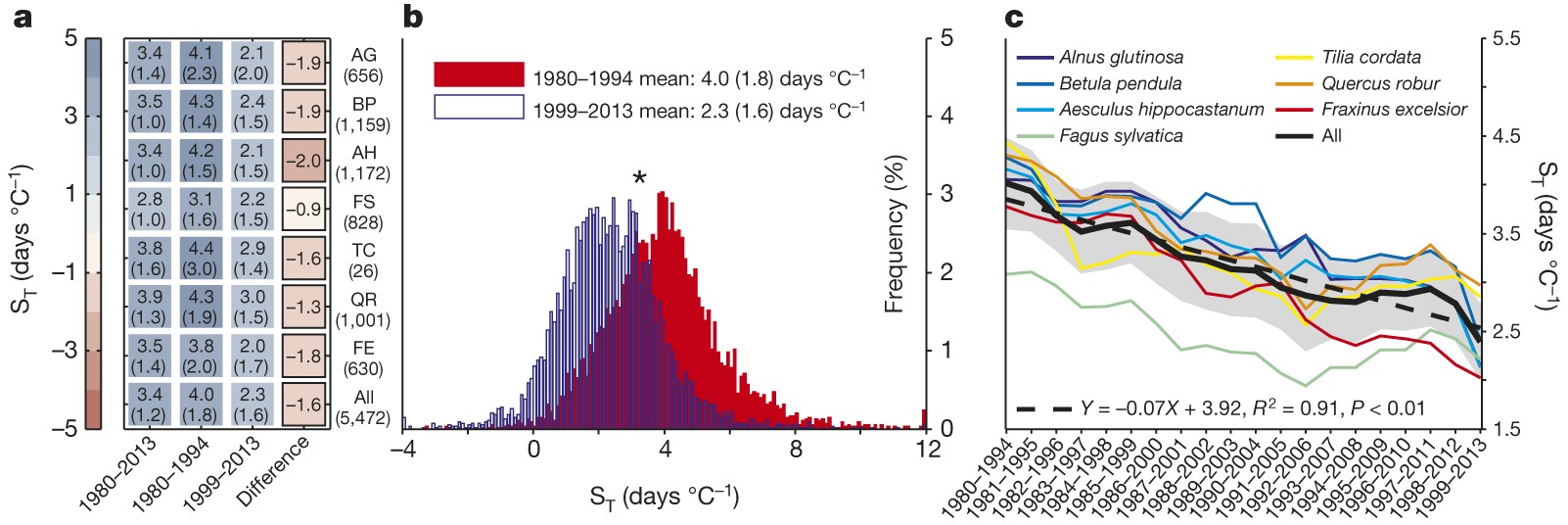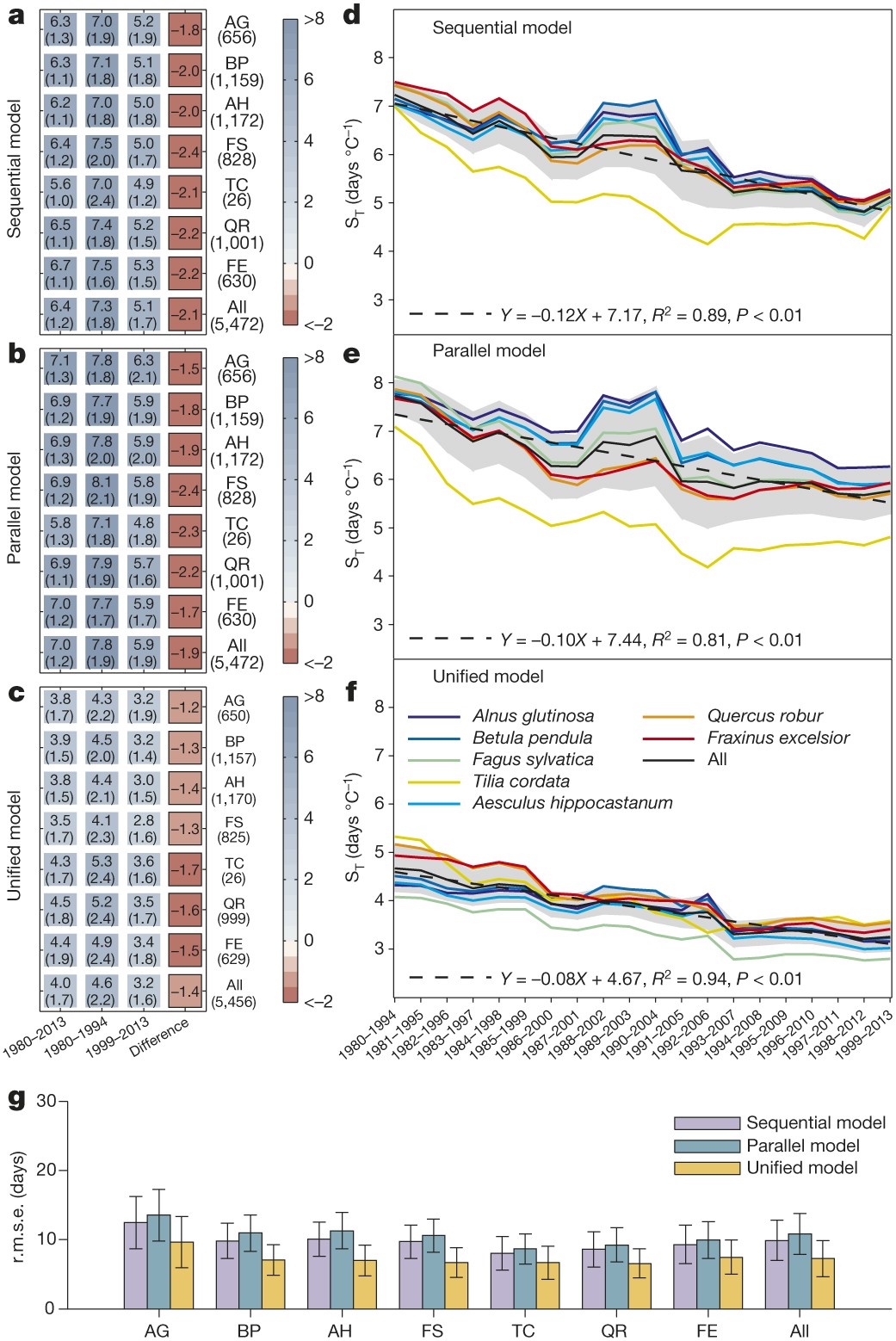文章信息:Fu Yongshuo H., Zhao Hongfang, Piao Shilong, Marc Peaucelle, Peng Shushi, Zhuo Guiyun, Philippe Ciais, Huang Mengtian, Annette Menzel, Josep Peñuelas, Song Yang, Yann Vitasse, Zeng Zhenzhong & Ivan A. Janssens. (2015). Declining global warming effects on the phenology of spring leaf unfolding. Nature: 526(7571), 104–107. https://doi.org/10.1038/nature15402
整理人:杨文,2023级硕士生
整理时间:2024年7月6日
Abstract: Earlier spring leaf unfolding is a frequently observed response of plants to climate warming1,2,3,4. Many deciduous tree species require chilling for dormancy release, and warming-related reductions in chilling may counteract the advance of leaf unfolding in response to warming5,6. Empirical evidence for this, however, is limited to saplings or twigs in climate-controlled chambers7,8. Using long-termin situobservations of leaf unfolding for seven dominant European tree species at 1,245 sites, here we show that the apparent response of leaf unfolding to climate warming (ST, expressed in days advance of leaf unfolding per °C warming) has significantly decreased from 1980 to 2013 in all monitored tree species. Averaged across all species and sites, STdecreased by 40% from 4.0 ± 1.8 days °C−1during 1980–1994 to 2.3 ± 1.6 days °C−1during 1999–2013. The declining STwas also simulated by chilling-based phenology models, albeit with a weaker decline (24–30%) than observedin situ. The reduction in STis likely to be partly attributable to reduced chilling. Nonetheless, other mechanisms may also have a role, such as ‘photoperiod limitation’ mechanisms that may become ultimately limiting when leaf unfolding dates occur too early in the season. Our results provide empirical evidence for a declining ST, but also suggest that the predicted strong winter warming in the future may further reduce STand therefore result in a slowdown in the advance of tree spring phenology.
摘要:早春叶片展开是植物对气候变暖的常见反应之一。许多落叶树种需要低温休眠释放,而与变暖相关的低温减少可能会抵消叶片展开在气候变暖下的提前。然而,关于这一点的实证证据仅限于气候控制室中的幼苗或小树枝。通过在1,245个观测点对七种主要欧洲树种的叶片展开进行长期实地观测,我们发现从1980年至2013年,树木叶片展开对气候变暖的明显反应(ST,每摄氏度变暖提前几天叶片展开)在所有监测的树种中显著减少。在所有物种和地点上平均,ST从1980-1994年的4.0 ± 1.8天°C−1减少到1999-2013年的2.3 ± 1.6天°C−1,减少了40%。通过基于低温的物候模型模拟了ST的下降,尽管下降幅度(24-30%)比实地观测的要弱。ST的降低可能部分归因于低温的减少。然而,其他机制可能也发挥作用,比如“光周期限制”机制,当叶片展开日期过早发生在季节初期时可能变得最终有限。我们的研究结果提供了一个ST减少的实证证据,但同时也暗示了未来预测中冬季明显的变暖可能会进一步降低ST,因此导致树木春季物候提前的减缓。

图 叶片展开的明显温度敏感性(ST)随时间的变化
a,三个时期所有地点的特定物种ST和标准偏差(括号内)及其在1999年至2013年和1980年至1994年之间的差异。ST是在1980年至2013年时间段内使用普通最小二乘线性回归确定的。颜色标尺表示ST的大小。AG,桦树(Alnus glutinosa);BP,白桦树(Betula pendula);AH,七叶树(Aesculus hippocastanum);FS,山毛榉(Fagus sylvatica);TC,菩提树(Tilia cordata);QR,橡树(Quercus robur);FE,梣(Fraxinus excelsior)。每种物种的地点数在物种名称下面的括号中。b,不同时期所有物种和地点的ST分布,以及平均ST和标准偏差(括号内)。星号表示两个时期之间ST的显着差异为P < 0.05。c,从1980年到2013年,在所有地点对每个物种和所有物种的总和的15年移动窗口中ST的时间变化。黑线表示所有物种的平均值,灰色区域表示均值两侧一个标准偏差。虚线表示线性回归。

图 叶片展开的感觉温度敏感性模型的变化
a-c,如图1a所示,这些面板显示了模拟的物种特异性ST,包括所有站点在三个时期的标准偏差(括号中),以及1999-2013年和1980-1994年之间的差异,分别为顺序模型(a),并行模型(b)和统一模型(c)。D-F,如图1c所示,这些面板显示了单个物种和所有站点所有物种的组合总数的ST的模拟时间变化,时间跨度为1980年至2013年,采用15年移动窗口,分别为顺序模型(d),并行模型(e)和统一模型(f)。G,模型性能。ST是使用季前赛期固定在时间段1980-2013年,并使用普通最小二乘线性回归来确定的。颜色标度表示ST的大小。r.m.s.e.,均方根误差;AG,桤木(Alnus glutinosa);BP,银桦(Betula pendula);AH,七叶树(Aesculus hippocastanum);FS,山毛榉(Fagus sylvatica);TC,菩提树(Tilia cordata);QR,橡树(Quercus robur);FE,白蜡树(Fraxinus excelsior)。每个物种的站点数量在物种名称下方的括号中。
原文链接:https://www.nature.com/articles/nature15402